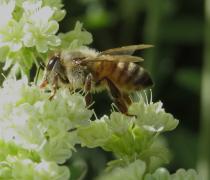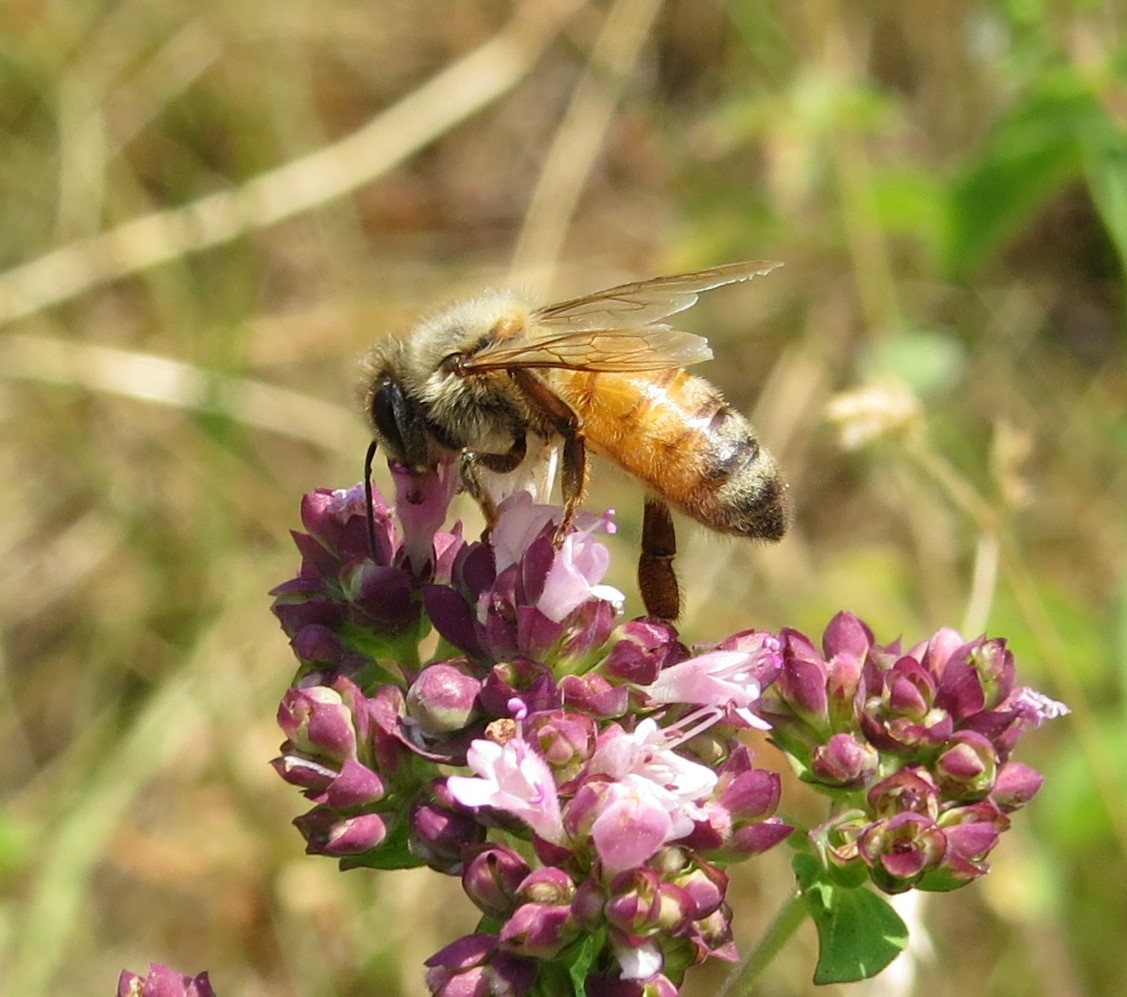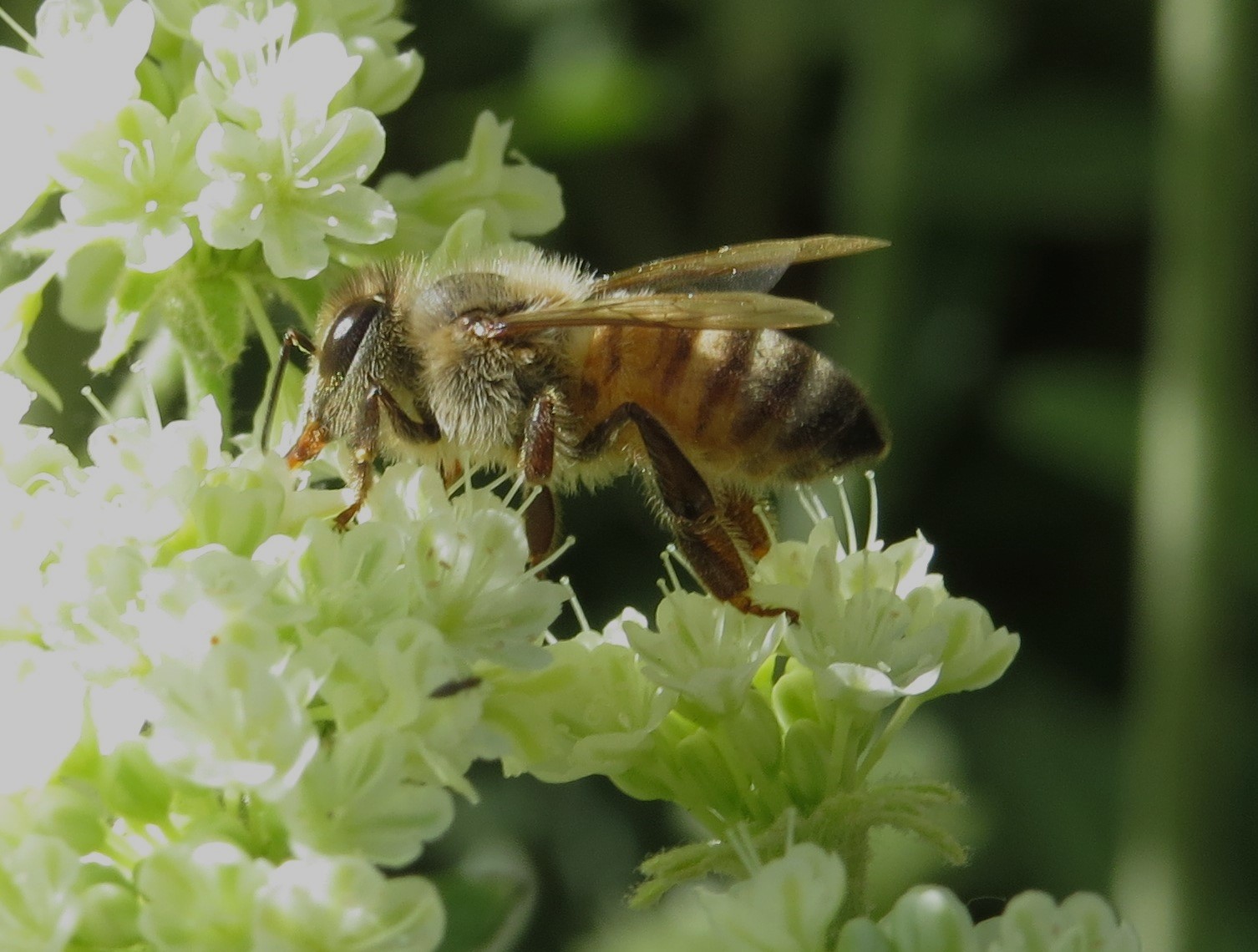Introduced Species
Honey bees are frequent visitors to the yard. They may, in fact, be the most common species of bee in the yard.
I'm not sure where they are coming from, but I know there are hives at PCEI, which is less than a kilometer away.
 1 June 2018
1 June 2018
- Links
- iNaturalist
- Wikipedia
- BugGuide
Apis mellifera
(Western Honey Bee)
Associated Species: Ocimum basilicum (Sweet Basil)
Apis mellifera
(Western Honey Bee)
Apis mellifera
(Western Honey Bee)
Associated Species: Cirsium arvense (Creeping Thistle)
Apis mellifera
(Western Honey Bee)
27 Jul 2024
Associated Species: Origanum vulgare (Oregano)
Apis mellifera
(Western Honey Bee)
On oregano flowers
Associated Species: Origanum vulgare (Oregano)
Apis mellifera
(Western Honey Bee)
25 Jul 2024
On globe thistle
Associated Species: Echinops Sp (Globe Thistles)
Apis mellifera
(Western Honey Bee)
25 Jul 2024
On oregano
Associated Species: Origanum vulgare (Oregano)
Apis mellifera
(Western Honey Bee)
Associated Species: Lavandula angustifolia (Common Lavender)
Apis mellifera
(Western Honey Bee)
24 Jun 2024
On
Eriogonum heracleoides (Parsnipflower Buckwheat) flowers
Associated Species: Eriogonum heracleoides (Parsnipflower Buckwheat)
Apis mellifera
(Western Honey Bee)
On raspberry flower
Associated Species: Rubus idaeus (Red Raspberry)
Apis mellifera
(Western Honey Bee)
On Sticky Geranium
Apis mellifera
(Western Honey Bee)
Apis mellifera
(Western Honey Bee)
On Big Sage flowers
Apis mellifera
(Western Honey Bee)
On Big Sage flowers
Apis mellifera
(Western Honey Bee)
Apis mellifera
(Western Honey Bee)
Apis mellifera
(Western Honey Bee)
Apis mellifera
(Western Honey Bee)
Apis mellifera
(Western Honey Bee)
Apis mellifera
(Western Honey Bee)
Apis mellifera
(Western Honey Bee)
Associated Species: Lavandula angustifolia (Common Lavender)
Apis mellifera
(Western Honey Bee)
Apis mellifera
(Western Honey Bee)
Apis mellifera
(Western Honey Bee)
Associated Species: Petroselinum crispum (Garden Parsley)
Apis mellifera
(Western Honey Bee)
Associated Species: Lavandula angustifolia (Common Lavender)
s_idstdClass Object
(
[id] => 31
[genus_id] => 56
[species_name] => mellifera
[common_name] => Western Honey Bee
[species_text] =>
Honey bees are frequent visitors to the yard. They may, in fact, be the most common species of bee in the yard.
I'm not sure where they are coming from, but I know there are hives at PCEI, which is less than a kilometer away.
 1 June 2018
1 June 2018
- Links
- iNaturalist
- Wikipedia
- BugGuide
[cultivated] => 0
[introduced] => 1
)
stdClass Object
(
[id] => 1243
[k_id] => 1
[p_id] => 2
[sp_id] => 1
[c_id] => 7
[sc_id] => 1
[o_id] => 8
[so_id] => 1
[io_id] => 1
[supf_id] => 13
[f_id] => 29
[sf_id] => 34
[t_id] => 22
[st_id] => 0
[g_id] => 56
[sg_id] => 5
[s_id] => 31
[ss_id] => 0
[o_desc] =>
[o_time] => 1508882400
[inat_time] => 1508882400
[cat_id] => 27
[o_image] =>
[o_featured] => 0
[inat_url] => https://www.inaturalist.org/observations/8550674
[inat_image_url] => https://inaturalist-open-data.s3.amazonaws.com/photos/11425342/large.jpeg
[o_short_desc] =>
[lowest_level] => s_id
[llid] => 1
[cultivated] => 0
[introduced] => 1
[good_image] => 1
[pollinating] => 0
[pollinating_level] =>
[eco_interaction] => 0
[gender] =>
[research_grade] => 0
[beeatlas] =>
[admin_notes] =>
)

Apis mellifera
(Western Honey Bee)
Taxonomy
Subclass:
Pterygota (Winged and Once-winged Insects)
Suborder:
Apocrita (Narrow-waisted Wasps, Ants, and Bees)
Infraorder:
Aculeata (Ants, Bees, and Stinging Wasps)
Superfamily:
Apoidea (Bees and Apoid Wasps)
Family:
Apidae (Honey Bees, Bumble Bees, and Allies)
Subfamily:
Apinae (Apine Bees)
Tribe:
Apini (Honey Bees)
Subgenus:
Apis (Cavity-nesting Honey Bees)
No lower level information

























